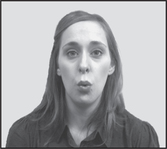Awareness | Tuning | Rounded Vowels | Nasal Vowels | English Tendencies | Consonants | Phonetic Notation Key
The Rounded Vowels of French
The vowels you reviewed on the last page were all oral and unrounded. In this section, we will focus on the rounded vowels of French.
There are three relevant features of a vowel sound:
There are three relevant features of a vowel sound:
- Tongue Position (Open/Closed & Back/Front)
- Roundedness (Rounded/Unrounded)
- Nasalization (Oral/Nasal)
French Rounded Vowels
|
There are three rounded vowels in French. You can hear them in the audio file to the right. They appear in the following order (these are their IPA symbols). y...ø...œ |
|
The Trick to Making Unrounded Vowels
The trick to figuring out how to make the French rounded vowels is knowing their Unrounded counterpart.
That means that the ONLY physical difference between the articulation of these two sounds is the roundedness of your lips.
So, /i/ is the unrounded counter part of /y/. When you make the /i/ sound, your lip muscles are completely relaxed. Now, if you keep the EXACT SAME tongue position while rounding lips you will make the sound /y/.
That means that the ONLY physical difference between the articulation of these two sounds is the roundedness of your lips.
So, /i/ is the unrounded counter part of /y/. When you make the /i/ sound, your lip muscles are completely relaxed. Now, if you keep the EXACT SAME tongue position while rounding lips you will make the sound /y/.
Unrounded ----- Rounded
i ----- y*
e ----- ø
ɛ ----- œ
*This is the IPA symbol; not to be confused it with the English letter "y"
The audio files below show this relationship for each of the three vowel pairs. Try to mimic me exactly.
- Start by saying the unrounded vowel continuously
- Without stopping the sound, round your lips WITHOUT changing anything else in your mouth, especially not your tongue position.
- Still not stopping the sound, relax your lips again to return back to the original, unrounded vowel sound.
- Alternate back and forth between rounded and unrounded in the same breath, once again moving nothing but your lips.
- Finally, try to pinpoint hit the rounded vowel without transitioning from the unrounded one.
i ----- y |
e ----- ø |
ɛ ----- œ |
As mentioned before, some of these sounds will be tricky to hit consistently in real time, but if you remember these steps, you can always find the vowel you need. With enough practical experience mimicking French and singing song lyrics, these rounded vowels will become as comfortable as any other.
Learning the Rounded Vowels
Like I said before, rounding does occur in English but it doesn't have any real purpose in distinguishing words.
I've created some audio files comparing each of the rounded vowels. Listen as often as you can and try your best to mimic the difference. Once again, the trick in mimicking is to conceptualize these vowels with their unrounded counterparts. In each audio file, I start by comparing the two unrounded vowels, then I compare the two rounded counterparts.
For example, the tongue adjustment you make to go from /i/ to /e/ (open slightly) will be THE EXACT SAME tongue adjustment you make to go from /y/ to /ø/.
I've created some audio files comparing each of the rounded vowels. Listen as often as you can and try your best to mimic the difference. Once again, the trick in mimicking is to conceptualize these vowels with their unrounded counterparts. In each audio file, I start by comparing the two unrounded vowels, then I compare the two rounded counterparts.
For example, the tongue adjustment you make to go from /i/ to /e/ (open slightly) will be THE EXACT SAME tongue adjustment you make to go from /y/ to /ø/.
|
|
|
The rounded vowel /ø/ also sounds similar to the unrounded vowel /ə/ to untrained ears, so I made another track comparing the the two. To give you a practical example of the difference, I end the track saying the words "I can" in french.
The word for "I" uses the /ə/ vowel, and the word for "can" uses the /ø/ vowel. Try to listen for the distinction and mimic.
The word for "I" uses the /ə/ vowel, and the word for "can" uses the /ø/ vowel. Try to listen for the distinction and mimic.
It will take a little practice for your ears and mouth to adjust to the French rounded vowels, so do not be frustrated if you are not able to do it on your first try.
You will refer to this page often as you gain practical experience with these sounds and try to make sense of your new knowledge.
You will refer to this page often as you gain practical experience with these sounds and try to make sense of your new knowledge.
Once you are comfortable with the information on this page, you may move on to the next section - Nasal Vowels
Awareness | Tuning | Rounded Vowels | Nasal Vowels | English Tendencies | Consonants | Phonetic Notation Key


